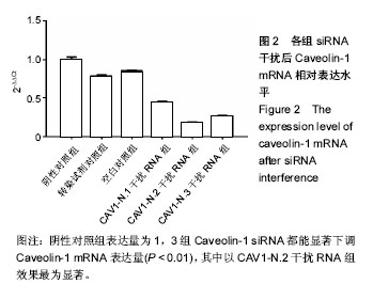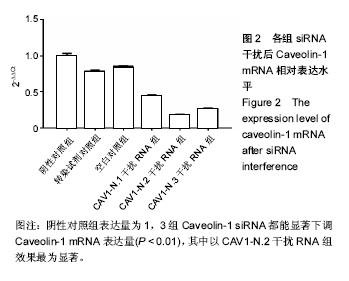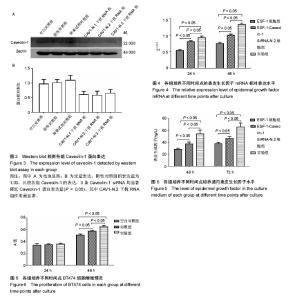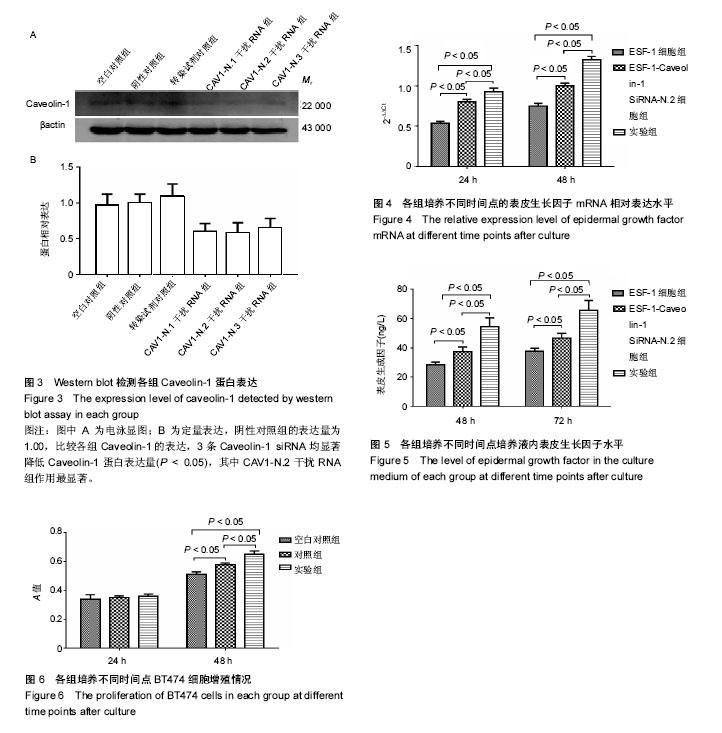| [1] Criscitiello C,Esposito A,Curiqliano G.Tumor-stroma crosstalk:targeting stroma in breast cancer.Curr Opin Oncol. 2014;26:551-555.[2] Williams TM,Sotgia F,Lee H,et al.Stromal and epithelial Caveolin-1 both confer a protective effect against mammary hyperplasia and tumorigenesis: Caveolin-1 antagonizes cyclin D1 function in mammary epithelial cells.Am J Pathol. 2006;169(5):1784-1801.[3] Savage K,Lambros MB,Robertson D,et al.Caveolin-1 is overexpressed and amplified in a subset of basal-like and metaplastic breast carcinomas:a morphologic, ultrastructural, immunohistochemical, and in situ hybridization analysis.Clin Cancer Res.2007;13:90-101.[4] Liedtkeg C,Kersting C,Burger H,et al.Caveolin-1 expression in bengin and malignant lesions of the breast.World J Surg Oncol.2007;5:110.[5] Anwar SL,Wahyono A,Aryandono T,et al.Caveolin-1 in Breast cancer:single molecule regulation of multiple key signaling pathways.Asian Pac J Cancer Prev.2015;16:6803-6812.[6] Drab M,Verkade P,Elger M,Kasper M,et al.Loss of caveolae,vascular dysfunction, and pulmonary defects in Caveolin-1 gene-disrupted mice.Science.2001;293: 2449-2452.[7] Razani B,Woodman SE,Lisanti MP.Caveolae: from cell biology to animal physiology.Pharmacol Rev.2002;54: 431-467.[8] Scherer PE,Lewis RY,Volonte D,et al.Cell-type and tissue-specific expression of caveolin-2. Caveolins 1 and 2 co-localize and form a stable hetero-oligomeric complex in vivo.J Biol Chem.1997;272(46):29337-29346.[9] Mercier I,Jasmin JF,Pavlides S,et al.Clinical and translational implications of the caveolin gene family: lessons from mouse models and human genetic disorders.Lab Invest.2009;89: 614-623.[10] Quest AF,Lobos-González L,Nuñez S,et al.The caveolin-1 connection to cell death and survival.Curr Mol Med.2013; 13(2):266-281.[11] Boscher C,Nabi IR.Galectin-3-and phospho-caveolin-1 dependent outside-in integrin signaling mediates the EGF motogenic response in mammary cancer cells.Mol Biol Cell. 2013;24:2134-2145.[12] Thomas NB,Hutcheson IR,Campbell L,et al.Growth of hormone-dependent MCF-7 breast cancer cells is promoted by constitutive caveolin-1 whose expression is lost in an EGF-R-mediated manner during development of tamoxifen resistance.Breast Cancer Res Treat.2010;119(3):575-591.[13] Shi XY,Xiong LX,Xiao L,et al.Downregulation of caveolin?1 upregulates the expression of growth factors and regulators in co?culture of fibroblasts with cancer cells.Mol Med Rep. 2016;13(1):744-752.[14] 石小玉,肖亮,熊丽霞,等.Caveolin-1-siRNA对与乳腺癌细胞共培养的成纤维细胞自噬体表达影响的研究[J].中国细胞生物学学报,2015,37(3):212-220.[15] Sloan EK,Ciocca DR,Pouliot N,et al.Stromal cell expression of Caveolin-1 predicts outcome in breast cancer.Am J Pathol. 2009;174:2035-2043.[16] Williams TM,Medina F,Badano I,et al.Caveolin-1 gene disruption promotes mammary tumorigenesis and dramatically enhances lung metastasis invivo: role of Cav-1 in cell invasiveness and matrix met alloproteinase (MMP-2/9) secretion.J Biol Chem.2004;279: 51630-51646.[17] Hayashi K,Matsuda S,Machida K,et al.Invasion activating Caveolin-1 mutation in human scirrhous breast cancers. Cancer Res.2001;61:2361-2364.[18] Goetz JG,Lajoie P,Wiseman SM,et al.Caveolin-1 in tumor progression: the good,the bad and the ugly.Cancer Metastasis Rev.2008;27:715-735.[19] Lock R,Debnath J.Extracellular matrix regulation of autophagy. Curr Opin Cell Biol.2008;20:583-588.[20] Fiucci G,Ravid D,Reich R,et al.Caveolin-1 inhibits anchorage-independent growth, anoikis and invasiveness in MCF-7 human breast cancer cells.Oncogene.2002;21: 2365-2375.[21] Engelman JA,Wykoff CC,Yasuhara S,et al.Recombinant expression of Caveolin-1 in oncogenically transformed cells abrogates anchorage-independent Growth.Biol Chem.1997; 272:16374-16381.[22] Glait C,Ravid D,Lee SW,et al.Caveolin-1 controls BRCA1 gene expression and cellular localization in human breast cancer cells.FEBS Lett.2006;580:5268-5274.[23] Lanuti M,Liu G,Goodwin JM,et al.A functional epidermal growth factor(EGF) polymorphism,EFG serum levels,and esophageal adenocarcinoma risk and outcome.Clin Cancer Res,2008,14:3216-3222.[24] Kim J,Kong J,Chang H,et al.EGF induces epithelial- mesenchymal transition through phospho-Smad2/3-Snail signaling pathway in breast cancer cells.Oncotarget.2016.doi: 10.18632/oncotarget.13116.[Epub ahead of print][25] Kainulainen V,Sundwall M,Maatta JA,et al.A natural ErbB4 isform that does not activate phosphoinositide 3-kinase mediates proliferation but not survival or chemotaxis.J Biol Chem.2000;275:8641-8649.[26] Shlessinger J.Cell signaling by receptor tyrosine kinases.Cell. 2002;103:211-225.[27] Mouneimne G,Desmarais V,Sidani M,et al.Spatial and temporal control of cofilin activity is required for directional sensing during chemotaxis.Curr Biol.2006;16:2193-2205.[28] Chan AY,Raft S,Bailly M,et al.EGF stimulates an increase in actin nucleation and filament number at the leading edge of the lamellipod in mammary adenocarcinoma cells.J Cell Sci. 1998;111:199-211.[29] Wang W,Eddy R,Condeelis J.The cofilin pathway in breast cancer invasion and metastasis.Nat Rev Cancer.2007;7: 429-440.[30] Al Moustafa AE,Achkhar A,Yasmeen A.EGF-receptor signaling and epithelial-mesenchymal transiton in hunman carcinomas.Front Biosci(Schol ED).2012;4:671-684.[31] Boccaccio C,Luraqhi P,Comoqlio PM.MET-mediated resistance to EGFR inhibitors:an old liaison rooted in colorectal cancer stem cells.Cancer Res.2014;74:3647-3651.[32] Luan TY,Zhu TN,Cui YJ,et al.Expression of caveolin-1 is correlated with lung adenocarcinoma proliferation, migration, and invasion.Med Oncol.2015;32(7):207.[33] Moreno-Càceres J,Caja L,Mainez J,et al.Caveolin-1 is required for TGF-β-induced transactivation of the EGF receptor pathway in hepatocytes through the activation of the metalloprotease TACE/ADAM17.Cell Death Dis.2014;5: e1326.[34] Yu XW,Lin S,Du HZ,et al.Synergistic combination of DT-13 and topotecan inhibits human gastric cancer via myosin IIA-induced endocytosis of EGF receptor in vitro and in vivo.Oncotarget.2016;7:32990-3003.[35] Agelaki S,Spiliotaki M,Markomanolaki H,et al.Caveolin-1 regulates EGFR signaling in MCF-7 breast cancer cells and enhances gefitinib-induced tumor cell inhibition.Cancer Biol Ther.2009;8915:1470-1477. |



